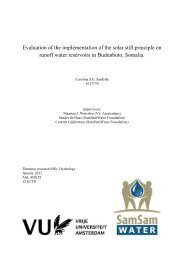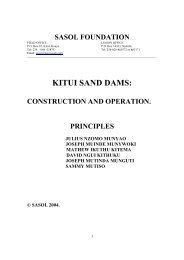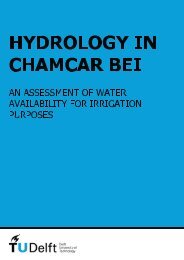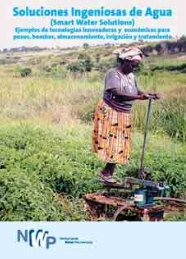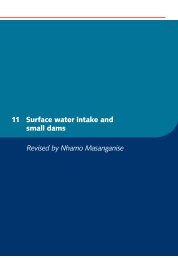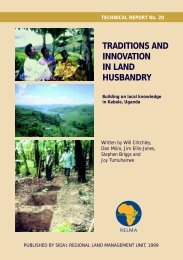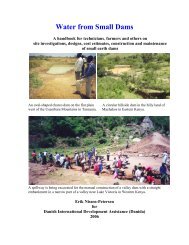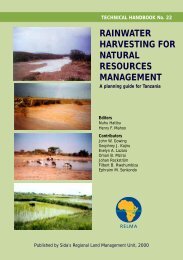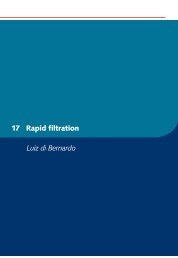Hydrogeology and siting of micro-dams around Léo Burkina Faso
Hydrogeology and siting of micro-dams around Léo ... - SamSamWater
Hydrogeology and siting of micro-dams around Léo ... - SamSamWater
Create successful ePaper yourself
Turn your PDF publications into a flip-book with our unique Google optimized e-Paper software.
<strong>Hydrogeology</strong> <strong>and</strong> <strong>siting</strong> <strong>of</strong> <strong>micro</strong>-<strong>dams</strong> <strong>around</strong> <strong>Léo</strong>, <strong>Burkina</strong> <strong>Faso</strong>14 June 2010round). Most probably not all <strong>of</strong> this ground water can be extracted, but this shows that the amount<strong>of</strong> ground water recharged by the <strong>micro</strong>-dam is significant.Apart from a year-round source for drinking water for cattle, brick making <strong>and</strong> washing, the <strong>micro</strong>damat Sanga adds 13,000 m 3 <strong>of</strong> groundwater to the area. Part <strong>of</strong> this infiltrated water is extracted bythe surrounding shallow wells <strong>and</strong> scoopholes for drinking <strong>and</strong> irrigation, another part percolatesdeeper into the ground <strong>and</strong> might recharge the deeper groundwater in the weathered <strong>and</strong> fracturedhard rocks. How much <strong>of</strong> the water will eventually flow towards these deeper aquifers is hard toestimate <strong>and</strong> depends on the local situation.4.6 Water balance Danfina (<strong>micro</strong>-dam constructed in 2008-2009)Using the same procedure as described above a water balance can be calculated for Danfina.In the case <strong>of</strong> Danfina, the water level at mid February was 0.66 m below the level <strong>of</strong> the spillway. Thelast rains had occurred at the end <strong>of</strong> October, so the 0.66 m drop in water level had occurred over aperiod <strong>of</strong> about 105 days.As at Sanga, evaporation has caused an estimated drop in water level <strong>of</strong> 0.46 m.The soil <strong>of</strong> the reservoir upstream <strong>of</strong> the Danfina <strong>micro</strong>-dam is more clayey than the soil in Sanga.When using the estimated low infiltration rate <strong>of</strong> 2 mm/day this will result in a drop <strong>of</strong> water level <strong>of</strong>0.21 m. In this case the evaporation <strong>and</strong> infiltration alone will result in a drop <strong>of</strong> water level <strong>of</strong> 0.67 m,which is about the same as the measured value <strong>of</strong> 0.66 m. Since water use by cattle <strong>and</strong> for brickmaking is not even taken into account this cannot be correct. So presumably the infiltration rate atDanfina is less than 2 mm/day.The estimated number <strong>of</strong> 1,000 cows that come to drink at the Danfina reservoir cause a drop inwater level <strong>of</strong> about 0.17 m. And the estimated 150 barrels a which are being filled result in a drop <strong>of</strong>about 0.19 m. Combined with the evaporation (but without infiltration) this adds up to a drop in waterlevel <strong>of</strong> 0.82 m, which is also more than the measured value <strong>of</strong> 0.66 m. So even when there is noinfiltration at all (which is unlikely) the estimations <strong>of</strong> evaporation <strong>and</strong> water use by cattle <strong>and</strong> brickmaking are too large. This means that either the evaporation or the use for cattle <strong>and</strong> brick making isoverestimated, or there is residual inflow <strong>of</strong> water to the reservoir (possibly delayed groundwater flowfrom the riverbanks or upstream).Additional measurements could indicate which <strong>of</strong> the parameters causes this difference. But based onthe measurements <strong>and</strong> estimations it can be said that the infiltration rate at Danfina is most probablylower than at Sanga, most likely <strong>around</strong> or lower than 2 mm/day. This corresponds to the fieldobservations since the soil <strong>of</strong> the reservoir was more clayey at Danfina compared to most other sites.4.7 Effect <strong>of</strong> a <strong>micro</strong>-dam on downstream water availabilityAn issue <strong>of</strong>ten raised regarding the construction <strong>of</strong> <strong>dams</strong> in arid areas is the effect on downstreamwater availability. Will the <strong>micro</strong>-dam reduce the water availability downstream?In the case <strong>of</strong> the <strong>micro</strong>-<strong>dams</strong> in this area that will not be the case. The effect on downstream wateravailability depends on the amount <strong>of</strong> water that is stored by the dam, compared to the total amount<strong>of</strong> water that flows through the river. If a substantial amount <strong>of</strong> the total discharge is stored upstream<strong>of</strong> a dam, downstream water availability might be at stake.Of the visited <strong>dams</strong>, Sanga has the smallest catchment size <strong>and</strong> is therefore the most sensitive in thisregard. Although even in the case <strong>of</strong> Sanga the <strong>micro</strong>-dam will only retain less than 0,5% <strong>of</strong> the totalamount <strong>of</strong> water that will flow through the river (volume <strong>of</strong> reservoir / (catchment size * averagerainfall * run<strong>of</strong>f coefficient)). Therefore there will be no negative downstream effects <strong>of</strong> a <strong>micro</strong>-dam.4.8 Hydrological monitoring systemA monitoring system was set up to monitor the hydrological situation at Sanga (where there is a<strong>micro</strong>-dam) <strong>and</strong> at Sissili (proposed dam site). The monitoring programme is added to this report inAppendix 2.22




